key points of the lectures
考研例句整理精华(都懂得必备)
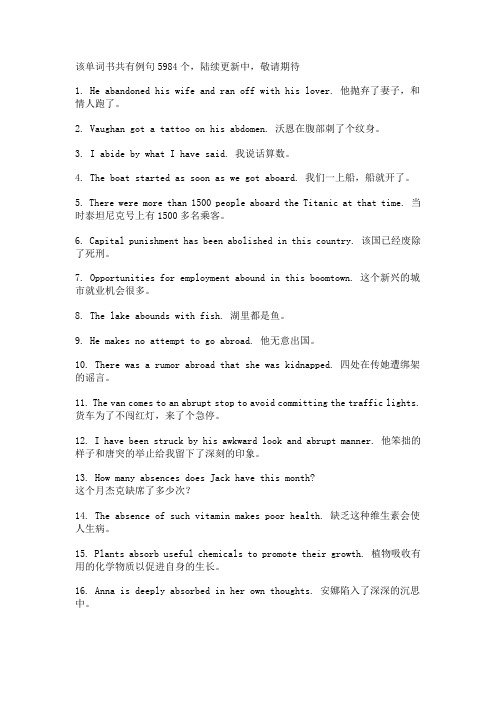
该单词书共有例句5984个,陆续更新中,敬请期待1. He abandoned his wife and ran off with his lover. 他抛弃了妻子,和情人跑了。
2. Vaughan got a tattoo on his abdomen. 沃恩在腹部刺了个纹身。
3. I abide by what I have said. 我说话算数。
4. The boat started as soon as we got aboard. 我们一上船,船就开了。
5. There were more than 1500 people aboard the Titanic at that time. 当时泰坦尼克号上有1500多名乘客。
6. Capital punishment has been abolished in this country. 该国已经废除了死刑。
7. Opportunities for employment abound in this boomtown. 这个新兴的城市就业机会很多。
8. The lake abounds with fish. 湖里都是鱼。
9. He makes no attempt to go abroad. 他无意出国。
10. There was a rumor abroad that she was kidnapped. 四处在传她遭绑架的谣言。
11. The van comes to an abrupt stop to avoid committing the traffic lights. 货车为了不闯红灯,来了个急停。
12. I have been struck by his awkward look and abrupt manner. 他笨拙的样子和唐突的举止给我留下了深刻的印象。
13. How many absences does Jack have this month?这个月杰克缺席了多少次?14. The absence of such vitamin makes poor health. 缺乏这种维生素会使人生病。
[北科大]通用学术英语2 Unit1 Mini-lecture
![[北科大]通用学术英语2 Unit1 Mini-lecture](https://img.taocdn.com/s3/m/4d46e480bcd126fff6050b6e.png)
Questions on mini-lectures in Unit1Mini-lecture11.What are the two types of writing in terms of their purposes?Persuasive and informative.2.What is the purpose of persuasive and informative writing respectively?Persuasive writing's purpose is to argue and influence thought.Informative writing's purpose is to convey information and educate its audience.3.What is a thesis?A thesis is a proposition or claim that is central to any piece of academic writing.4.What is the process of constructing a thesis?The process of constructing a thesis leads from the literature research, through the introduction, and finally to the thesis statement.5.What are the features of a thesis statement?The thesis statement is made in the introduction of the writing, following the contextualization. Usually it is short as one or two sentences.6.What is a hypothesis in scientific writing?Hypothesis is a proposed solution to an unexplained phenomenon.7.What is the relationship between the independent variable and the dependent variable?A change of the independent variable will have an effect on the dependent variable.8.What are the two ways of writing a scientific hypothesis and when are they used?Use an ‘if…then’ statement when there is an independent and dependent variable.Use a null hypothesis if it is unclear whether or not the relationship exists.9.What is the difference between aims and objectives? An d where are they usually stated in a paper?The aims of a project are its ultimate goals what the project hopes to achieve in its completion. The aims may be general, but they should be expressed clearly and concisely.The objectives are the steps that you will take to achieve the aims of the research. Each objective should be specific.They usually stated at the beginning of the paper, or implied in the introduction10.What does the S.M.A.R.T acronym mean when defining the objectives?Specific, measurable, achievable, realistic, time-constrained.Mini-lecture211.What are the steps that you can take to ensure responsive reading?Pause: Pause at the end of each section to ensure you understand each section before progressing further.Make notes: The process of note-taking allows you to gather your thoughts and arrange them in a clear and coherent way.Highlight: Before you make notes, highlight the key points of the text.12.What questions can you ask to help you identify literature gaps when you research a topic? What is the current trend in research?What is the generally accepted view on this topic?What questions remain to be answered?Mini-lecture313.What strategies are recommended to help you identify the main idea of a presentation?Pay attention to the beginning or the end of a lecture and focus on the language clues.Listen for repetition or other clues(a change in the speed of or tone of speech) if the mainidea or thesis statement is not explicitly stated.Mini-lecture414.What is the common way of developing a thesis?A commom way to develop a thesis is to begin by considering the topic of the essay, and then turn the topic into a thesis by narrowing down to a viewpoint or perspective.15.What is a sub-thesis?A sub-thesis is considered as a mini-thesis that will be used as the controlling idea of each section or paragraph.16.What are the questions you should ask to ensure that your thesis is effective and clear?Is there an argument?Is there a conuter-argument?Is it rational?Is it specific?Does it declare its reasoning?Mini-lecture517.Where is the old and new information presented in a sentence?The new information is at the end of sentences and the old information is at the beginning of sentences.18.What is often used to maintain the focus of a sentence?The passive voice.。
unit3 the key points of the Reading
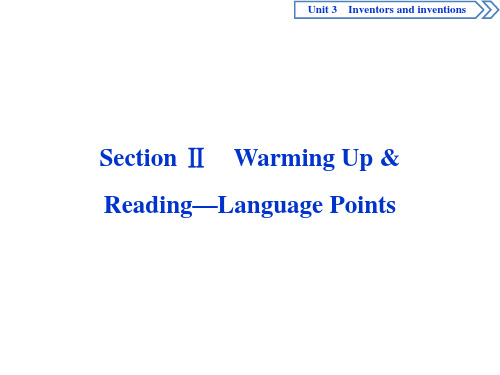
merciful adj.宽大的;仁慈的;慈悲的→mercy n.仁慈; 11._________
宽恕;怜悯
product n.产品→produce vt.生产→production n.生产 12.________ criterion n.(评判的)标准;尺度→pl. criteria 13.__________
期望;认为
栏目 导引
Unit 3
Inventors and inventions
recognition n.认出;认可;承认→recognize vt.认出 9.____________
passive adj.被动的;消极的;被动语态的→active adj.主 10.________
动的;积极的
栏目 导引
patent n. 3._______ valid adj. 4.______
Unit 3
Inventors and inventions
[拓展词汇]
abrupt adj.突然的;意外的→abruptly adv.突然地;唐突地 5._______ convenient adj.便利的; 6. ___________ 方便的; 就近的→convenience n. 方
栏目 导引
Unit 3
Inventors and inventions
caution
n.[U] 小心;谨慎;警告
(教材 P20)This time with great caution I bent down to examine the snakes and I found them very sleepy. 这一次我小心翼翼地蹲下去检查的时候,发现蛇都是睡意浓浓 的。
achievements. 诚实地说,我真羡慕你卓越的成就。
听力训练英语试题及答案
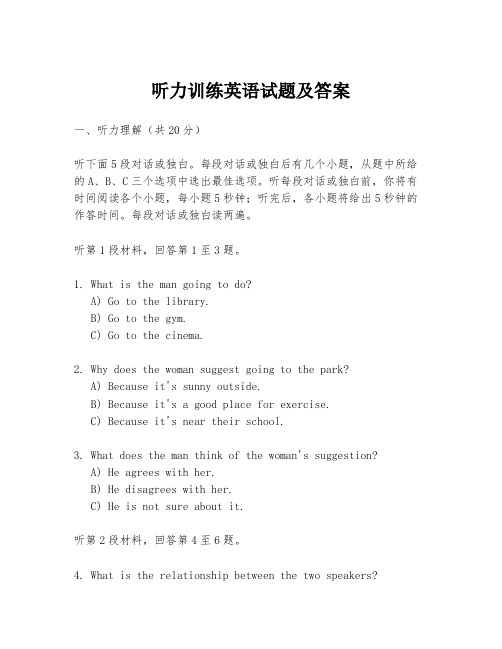
听力训练英语试题及答案一、听力理解(共20分)听下面5段对话或独白。
每段对话或独白后有几个小题,从题中所给的A、B、C三个选项中选出最佳选项。
听每段对话或独白前,你将有时间阅读各个小题,每小题5秒钟;听完后,各小题将给出5秒钟的作答时间。
每段对话或独白读两遍。
听第1段材料,回答第1至3题。
1. What is the man going to do?A) Go to the library.B) Go to the gym.C) Go to the cinema.2. Why does the woman suggest going to the park?A) Because it's sunny outside.B) Because it's a good place for exercise.C) Because it's near their school.3. What does the man think of the woman's suggestion?A) He agrees with her.B) He disagrees with her.C) He is not sure about it.听第2段材料,回答第4至6题。
4. What is the relationship between the two speakers?A) Teacher and student.B) Boss and employee.C) Friends.5. When is the meeting?A) At 9:00 a.m.B) At 10:00 a.m.C) At 11:00 a.m.6. What will the woman do after the meeting?A) Prepare a report.B) Go to a business trip.C) Attend a training session.听第3段材料,回答第7至9题。
英语chapter 1

What is expected from you?
Before the lecture: • Do some preparatory reading. • Find out what the lecture is about and look up some key words. During the lecture: • Takes notes while the lecturer is speaking • Do not talk to other students. Try to concentrate during the lecture. After the lecture • Do any follow-up reading suggested by your lecturer • Organize your notes and any handouts you are given.
Ideas for future research and reading.
A starting point for your own thoughts.
How is a lecture different from other forms of speaking?
• 1. The lecturer has prepared what he/she is going to say in
intensive listening for long periods of time to develop your understanding
of a topic, listening to explanations of assignments, listening to topics being discussed in seminars, listening to your lectures in tutorials.
写一篇你最喜欢的一件学习用品的英文作文

写一篇你最喜欢的一件学习用品的英文作文One of my favorite study tools is my trusty notebook. It may seem simple, but this basic tool has helped me stay organized and on track throughout my academic journey.I remember choosing my notebook carefully at the beginning of each school year, searching for one that was the perfect size, color, and style. The act of selecting a notebook was always exciting for me, as it symbolized a fresh start and new possibilities for learning.Once I had my notebook in hand, I would label it with my name and subject, creating a sense of ownership over my studies.I would also decorate the cover with stickers or doodles, addinga personal touch to make it truly mine.As I began using my notebook in class, I found that it was more than just a place to take notes. It became a record of my thoughts, ideas, and discoveries. I would jot down key points from lectures, draw diagrams to visualize complex concepts, and write out questions to explore further.My notebook also served as a tool for reflection andself-assessment. I would review my notes regularly, highlighting important information and identifying areas where I needed tofocus more attention. This practice helped me stay engaged and motivated in my studies.In addition to taking notes in class, my notebook was a valuable resource for studying at home. I would use it to create study guides, write practice essays, and make flashcards for memorizing key facts. The act of physically writing out information helped me retain it better than simply typing on a computer.One of the aspects I love most about my notebook is its flexibility. I can organize my notes in whatever way works best for me, whether it's a traditional outline format, mind maps, or a combination of both. This freedom allows me to customize my study methods to suit my learning style and preferences.Overall, my notebook has been a constant companion in my academic journey, helping me stay organized, focused, and engaged in my studies. It may seem like a simple tool, but its impact on my learning process has been profound. I am grateful for the opportunity to use such a versatile and effective study aid, and I look forward to continuing to fill its pages with knowledge and insights in the future.。
Key+points+of+grammar+in+the+English+Level+2+exam

The correct use of tenses
Present simple
This tense is used to describe actions that are happening now, such as "I eat pizza every day."
Past simple
This tense is used to describe actions that happened in the past, such as "Yesterday, I ate pizza."
The modifying function of adjectives
adjectives are used to describe or modify nouns or pronouns. For example, in the sentence "The red car is fast," the adjective "red" describes the color of the car, and the adjective "fast" describes the speed of the car.
Use of articles
Articles are used with nouns to create noun phrases. The article agrees with the noun in case, number, and gender.
Common test points for nouns and articles
• Use of possessive pronouns: Possessive pronouns (mine, yours, his, hers, its, ours, theirs) are used to show possession and must agree with the noun they modify in gender and number.
黑龙江省学位英语作文模板

黑龙江省学位英语作文模板Heilongjiang Province is a region located in the northeastern part of China, known for its diverse landscapes, rich cultural heritage, and vibrant academic institutions. As a province that places a strong emphasis on education, Heilongjiang has developed a comprehensive system for evaluating the English proficiency of its students, including the implementation of the Postgraduate English Exam (PEE). This exam, which is a mandatory requirement for students seeking to pursue postgraduate studies, serves as a crucial assessment of their English language skills.The PEE in Heilongjiang Province follows a well-structured format that aims to evaluate the candidates' abilities in various aspects of the English language. The exam typically consists of four main sections: Reading Comprehension, Listening Comprehension, Vocabulary and Grammar, and Writing. Each section is designed to assess the test-takers' proficiency in different areas of the language, providing a comprehensive evaluation of their overall English competency.The Reading Comprehension section of the PEE typically involves the analysis of several passages, ranging from academic articles to literary works. Candidates are required to demonstrate their understanding of the content, identify the main ideas, and answer a series of questions related to the given texts. This section not only tests the students' ability to comprehend written English but also their critical thinking skills and their capacity to interpret and analyze the information presented.The Listening Comprehension section of the PEE assesses the candidates' ability to understand spoken English in various contexts, such as lectures, conversations, and news reports. Participants are required to listen to audio recordings and answer questions based on the information they have heard. This section evaluates the students' ability to comprehend and process spoken English, which is a crucial skill for academic and professional success.The Vocabulary and Grammar section of the PEE focuses on the candidates' knowledge of English vocabulary and their understanding of grammatical structures. This section may involve tasks such as fill-in-the-blank exercises, sentence correction, and the identification of grammatical errors. By assessing the test-takers' command of vocabulary and grammar, this section ensures that the students have a solid foundation in the mechanics of the English language.The Writing section of the PEE is perhaps the most challenging and critical component of the exam. In this section, candidates are required to produce a well-structured, coherent, and well-reasoned essay on a given topic. The essay may address a range of themes, such as academic, social, or cultural issues, and the candidates are expected to demonstrate their ability to organize their thoughts, develop a logical argument, and express their ideas effectively in written English.To excel in the Writing section of the PEE, students in Heilongjiang Province must develop a comprehensive understanding of the essay writing process. This includes mastering the art of crafting a clear and compelling thesis statement, effectively organizing the essay's structure, providing relevant and well-supported evidence, and maintaining a consistent and appropriate tone throughout the piece.One of the key strategies for success in the PEE Writing section is the development of a standardized essay template. This template serves as a framework for the candidates to organize their thoughts and ensure that their essays meet the specific requirements of the exam. The template typically includes the following components:1. Introduction: The introduction should provide a clear and concise overview of the essay's topic, as well as a well-defined thesisstatement that outlines the main argument or position being presented.2. Body Paragraphs: The body paragraphs should each focus on a specific aspect of the essay's topic, providing detailed evidence and analysis to support the central argument. Each paragraph should have a clear topic sentence, and the information should be presented in a logical and coherent manner.3. Counterargument and Rebuttal: In this section, the candidate should acknowledge and address any potential counterarguments or opposing viewpoints, and then provide a well-reasoned rebuttal to strengthen their own position.4. Conclusion: The conclusion should effectively summarize the key points of the essay, reiterate the thesis statement, and leave the reader with a clear understanding of the candidate's position on the topic.By mastering this standardized essay template, students in Heilongjiang Province can develop a systematic approach to the PEE Writing section, ensuring that their essays are well-organized, thoughtful, and persuasive.In addition to the essay template, students preparing for the PEE inHeilongjiang Province should also focus on developing a strong command of English vocabulary, grammar, and writing mechanics. This can be achieved through regular practice, exposure to a wide range of academic and literary texts, and the development of effective study habits.Furthermore, students should familiarize themselves with the specific format and requirements of the PEE, as well as any potential changes or updates to the exam structure. By staying informed and adapting their study strategies accordingly, candidates can increase their chances of success on the PEE and ultimately enhance their prospects for postgraduate studies.In conclusion, the Postgraduate English Exam (PEE) in Heilongjiang Province serves as a critical assessment of students' English language proficiency, with the Writing section being a particularly crucial component. By developing a standardized essay template and focusing on the comprehensive development of their English language skills, students in Heilongjiang can position themselves for success on the PEE and pave the way for their future academic and professional pursuits.。
全国英语等级考试(PETS)(第三级)笔试写作部分

第三层内容
结束语
Yours sincerely,
祝福语
签名
Wang Lin
四、实例分析 Part B Directions: Read the text below. Write an essay in about 120 words, in which you should summarize the key points of the text and make comments on them. Try to use your own words.
三、写作指南 (二)Part B 材料作文
2. 常用句式和关联词 评论中表示“最重要的是”的词语: Most important of all, Last but not least 表示“引出例证”的: Therefore, From the above example 在评论过程中,需要前后衔接的常用句式: Admittedly... but it won't be the case that... They may be right in saying that... but they fail to notice that... It is natural to believe that... since... however, we cannot ignore...
3. 语言简洁、明了,表达出必须说明的内容即可。
四、实例分析 范文:
称呼 第一层内容
Dear Mr. Smith,
Due to the bad cold I got yesterday, I didn't feel well and
went to hospital. After the examination, the doctor suggested
听学术讲座对重要的点的总结英语作文
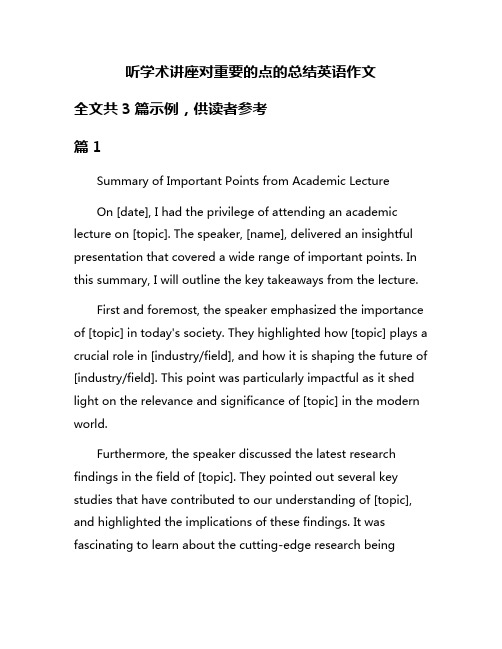
听学术讲座对重要的点的总结英语作文全文共3篇示例,供读者参考篇1Summary of Important Points from Academic LectureOn [date], I had the privilege of attending an academic lecture on [topic]. The speaker, [name], delivered an insightful presentation that covered a wide range of important points. In this summary, I will outline the key takeaways from the lecture.First and foremost, the speaker emphasized the importance of [topic] in today's society. They highlighted how [topic] plays a crucial role in [industry/field], and how it is shaping the future of [industry/field]. This point was particularly impactful as it shed light on the relevance and significance of [topic] in the modern world.Furthermore, the speaker discussed the latest research findings in the field of [topic]. They pointed out several key studies that have contributed to our understanding of [topic], and highlighted the implications of these findings. It was fascinating to learn about the cutting-edge research beingconducted in the field, and to see how it is pushing the boundaries of knowledge.Another important point that the speaker touched upon was the practical applications of [topic]. They provided examples of how [topic] is being used in real-world scenarios, and how it is making a tangible impact on [industry/field]. This practical perspective was valuable as it helped to connect the theoretical concepts of [topic] to their real-world applications.Additionally, the speaker discussed the challenges and limitations of [topic]. They highlighted the areas where further research is needed, and the obstacles that need to be overcome in order to advance our understanding of [topic]. This awareness of the limitations of [topic] was crucial in providing a balanced view of the subject.Overall, the academic lecture was a valuable experience that deepened my understanding of [topic]. The speaker's insights and perspectives were enlightening, and I left the lecture feeling inspired and motivated to learn more about [topic]. I am grateful to have had the opportunity to attend such an informative and engaging event.篇2Attending academic lectures is a valuable opportunity for students to gain knowledge and insights from experts in their field. It provides a platform for individuals to expand their understanding of complex topics and engage in intellectual discussions. In this essay, I will summarize the key points of a recent academic lecture I attended, highlighting the important takeaways that I believe are crucial for enhancing my learning and personal growth.The lecture I attended was on the topic of "The Future of Artificial Intelligence" delivered by Dr. James Smith, a renowned expert in the field of artificial intelligence. The lecture began with an overview of the current state of AI technology and its applications across various industries. Dr. Smith emphasized the rapid advancements in machine learning algorithms and the increasing role of AI in shaping the future of society.One of the key points discussed in the lecture was the ethical implications of AI technology. Dr. Smith highlighted the importance of ensuring that AI systems are developed and deployed in a responsible manner, taking into consideration ethical principles such as transparency, accountability, and fairness. He also emphasized the need for regulatory frameworks to govern the use of AI and prevent potential risks and harms.Another important aspect of the lecture was the impact of AI on the workforce and job market. Dr. Smith discussed the potential for AI to automate routine tasks and jobs, leading to significant disruptions in the labor market. He stressed the importance of upskilling and reskilling workers to adapt to the changing demands of the digital economy and ensure their employability in the future.The lecture also touched upon the opportunities and challenges of AI in healthcare, education, and other sectors. Dr. Smith highlighted the potential benefits of AI in improving healthcare outcomes, enhancing educational experiences, and driving innovation in various industries. However, he also warned of potential risks and biases in AI systems that could lead to unintended consequences and ethical dilemmas.Overall, the academic lecture was an enriching experience that broadened my understanding of the complexities and possibilities of artificial intelligence. It reinforced the importance of ethical considerations in AI development, the need for continuous learning and adaptation in a rapidly changing world, and the potential for AI to revolutionize various aspects of society.In conclusion, attending academic lectures provides a valuable opportunity for individuals to learn from experts, broaden their perspectives, and engage in intellectual discourse. The key points summarized from the lecture on the future of artificial intelligence underscore the importance of ethical considerations, the impact on the workforce, and the opportunities and challenges of AI in various sectors. By reflecting on and applying these key takeaways, I believe that I can better navigate the complexities of the digital age and contribute meaningfully to the advancement of society.篇3Summary of Key Points in Academic LectureAttending academic lectures is an important part of academic life for students and researchers. These lectures provide valuable insights, information, and updates on various topics and research areas. Summarizing the key points discussed in an academic lecture is crucial for retaining and applying the knowledge gained. In this article, we will provide a comprehensive summary of key points in an academic lecture on the topic of artificial intelligence (AI).The lecture started with an introduction to the concept of artificial intelligence and its significance in today's digital world. The speaker emphasized the role of AI in transforming industries such as healthcare, finance, and transportation. The discussion then moved on to the different types of AI, including narrow AI, general AI, and superintelligence. The speaker highlighted the potential risks and benefits associated with each type of AI.Next, the lecture delved into the various applications of AI in real-world scenarios. The speaker provided examples of how AI is being used in autonomous vehicles, facial recognition technology, and healthcare diagnostics. The audience was also informed about the current trends and advancements in AI research, such as deep learning, natural language processing, and reinforcement learning.One of the key points raised in the lecture was the ethical implications of AI. The speaker stressed the importance of establishing guidelines and regulations to ensure that AI is used responsibly and ethically. The audience was encouraged to think about the potential impact of AI on society, such as job displacement, privacy concerns, and bias in algorithms.Overall, the lecture provided a comprehensive overview of the key concepts, applications, and ethical considerations relatedto artificial intelligence. The audience left the lecture with a deeper understanding of the potential benefits and challenges of AI and how it will continue to shape our future. Summarizing the key points discussed in the lecture will help reinforce the knowledge gained and encourage further exploration of the topic.。
lecture_1_key_points
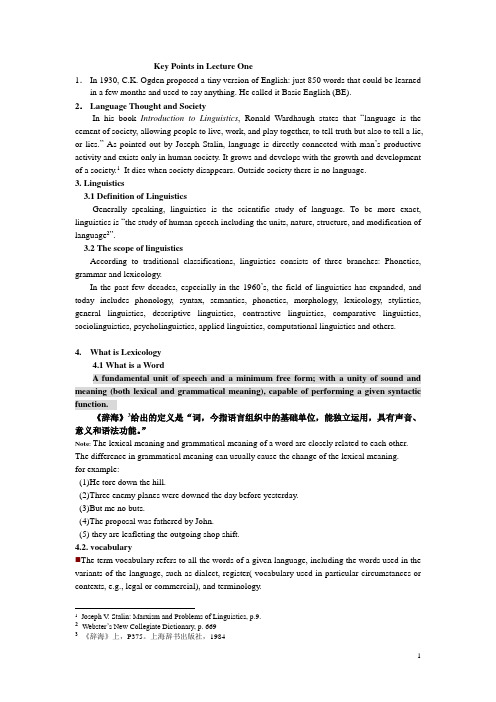
Key Points in Lecture One1.In 1930, C.K. Ogden proposed a tiny version of English: just 850 words that could be learned in a few months and used to say anything. He called it Basic English (BE).2.Language Thought and SocietyIn his book Introduction to Linguistics, Ronald Wardhaugh states that “language is the cement of society, allowing people to live, work, and play together, to tell truth but also to tell a lie, or lies.” As pointed out by Joseph Stalin, language is directly connected with man‟s productive activity and exists only in human society. It grows and develops with the growth and development of a society.1It dies when society disappears. Outside society there is no language.3. Linguistics3.1 Definition of LinguisticsGenerally speaking, linguistics is the scientific study of language. To be more exact, linguistics is “the study of human speech including the units, nature, structure, and modification of language2”.3.2 The scope of linguisticsAccording to traditional classifications, linguistics consists of three branches: Phonetics, grammar and lexicology.In the past few decades, especially in the 1960‟s, the field of linguistics has expanded, and today includes phonology, syntax, semantics, phonetics, morphology, lexicology, stylistics, general linguistics, descriptive linguistics, contrastive linguistics, comparative linguistics, sociolinguistics, psycholinguistics, applied linguistics, computational linguistics and others.4.What is Lexicology4.1 What is a WordA fundamental unit of speech and a minimum free form; with a unity of sound and meaning (both lexical and grammatical meaning), capable of performing a given syntactic function.《辞海》3给出的定义是“词,今指语言组织中的基础单位,能独立运用,具有声音、意义和语法功能。
英语作文讲座过程模板

英语作文讲座过程模板Template for Lecture Process。
Introduction:1. Greet the audience and introduce yourself.2. Explain the topic of the lecture and its importance.3. Briefly outline the structure of the lecture.Main Body:1. Provide background information on the topic.2. Present key concepts and theories related to the topic.3. Use examples and case studies to illustrate the concepts and theories.4. Provide data and statistics to support your arguments.5. Invite questions and comments from the audience.Conclusion:1. Summarize the key points of the lecture.2. Emphasize the importance of the topic and its relevance to the audience.3. Provide recommendations for further reading or research.4. Thank the audience for their attention and participation.As a student, attending lectures is an essential part of learning. Lectures are a great way to acquire new knowledge, gain insights, and broaden our perspectives.However, not all lectures are created equal. Some are engaging and informative, while others are dull and uninspiring. In this essay, I will use the template for lecture process to write about a lecture I attended recently.Introduction:Last month, I had the opportunity to attend a lecture on the topic of climate change. The lecture was delivered by a renowned expert in the field, Dr. John Smith, who has been studying climate change for over 20 years. The lecture was held at the local university and was attended by a diverse audience of students, professors, and members of the public.Dr. Smith began the lecture by introducing himself and explaining the importance of the topic of climate change. He emphasized that climate change is one of the most pressing issues facing our planet today and that it requires urgent action. He then outlined the structure of the lecture, which would cover the following topics: thecauses of climate change, the impacts of climate change, and the solutions to climate change.Main Body:Dr. Smith started the lecture by providing some background information on the topic of climate change. He explained that climate change refers to the long-term changes in the Earth's climate, which are primarily caused by human activities such as burning fossil fuels and deforestation. He then presented key concepts and theories related to climate change, such as the greenhouse effect and the carbon cycle. He used simple diagrams and analogies to explain these concepts, which made them easy to understand.Next, Dr. Smith used examples and case studies to illustrate the impacts of climate change. He showedpictures of melting glaciers, rising sea levels, and extreme weather events, such as hurricanes and droughts. He also explained how these impacts are affecting different regions of the world, such as Africa, Asia, and the Arctic.He used data and statistics to support his arguments, which made the lecture more convincing.Finally, Dr. Smith presented solutions to climate change. He discussed various strategies, such as renewable energy, energy efficiency, and carbon capture and storage. He explained how these strategies can reduce greenhouse gas emissions and mitigate the impacts of climate change. He also discussed the challenges and opportunities of implementing these strategies, such as the need for policy changes and technological innovations.Conclusion:In conclusion, the lecture on climate change by Dr.John Smith was informative and engaging. He used the template for lecture process to structure the lecture effectively and to make it easy to follow. He provided background information, presented key concepts and theories, used examples and case studies, and provided data and statistics to support his arguments. He also invited questions and comments from the audience, which made thelecture more interactive. Overall, the lecture was a great learning experience and I would recommend it to anyone interested in the topic of climate change.。
the tuter guided us to take of the key points -回复
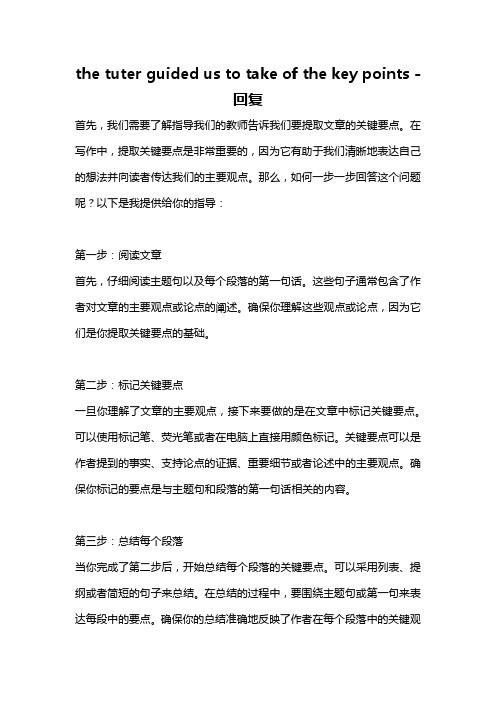
the tuter guided us to take of the key points -回复首先,我们需要了解指导我们的教师告诉我们要提取文章的关键要点。
在写作中,提取关键要点是非常重要的,因为它有助于我们清晰地表达自己的想法并向读者传达我们的主要观点。
那么,如何一步一步回答这个问题呢?以下是我提供给你的指导:第一步:阅读文章首先,仔细阅读主题句以及每个段落的第一句话。
这些句子通常包含了作者对文章的主要观点或论点的阐述。
确保你理解这些观点或论点,因为它们是你提取关键要点的基础。
第二步:标记关键要点一旦你理解了文章的主要观点,接下来要做的是在文章中标记关键要点。
可以使用标记笔、荧光笔或者在电脑上直接用颜色标记。
关键要点可以是作者提到的事实、支持论点的证据、重要细节或者论述中的主要观点。
确保你标记的要点是与主题句和段落的第一句话相关的内容。
第三步:总结每个段落当你完成了第二步后,开始总结每个段落的关键要点。
可以采用列表、提纲或者简短的句子来总结。
在总结的过程中,要围绕主题句或第一句来表达每段中的要点。
确保你的总结准确地反映了作者在每个段落中的关键观点。
第四步:总结全文当你完成对每个段落的总结之后,开始对全文进行总结。
再次强调文章的主要观点,并将每个段落的关键要点整合起来形成一个逻辑完整的文章总结。
在这一步中,你可以进行扩展、删除或者修改一些要点,以确保你的总结能够清晰地表达出作者的意图。
第五步:校对和润色最后一个步骤是校对和润色你的文章总结。
确保你没有遗漏任何关键要点,并且语言清晰、准确。
仔细检查语法、拼写和标点错误,并确保文章结构合理。
如果有需要,可以请同学或教师帮助你校对和提供建议。
总结一下,在写作中提取关键要点的过程中,首先阅读全文,然后标记关键要点,接着总结每个段落的要点,并最终总结全文。
最后,通过校对和润色来确保你的总结准确无误。
希望这些步骤对你有所帮助,并能在提取关键要点的过程中取得好的成果。
上课记笔记的重要性英语作文范文
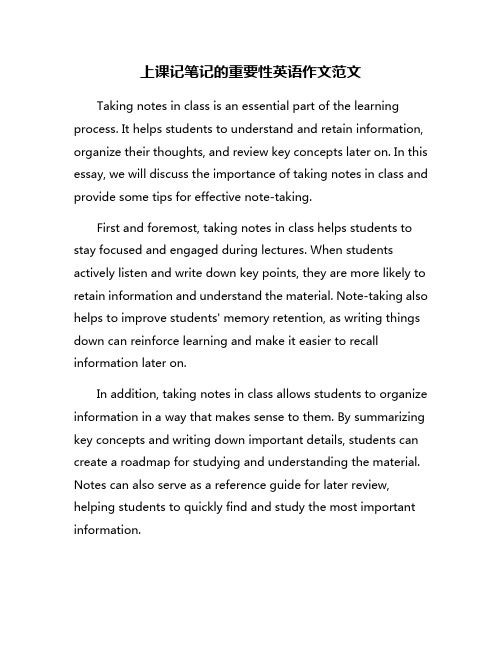
上课记笔记的重要性英语作文范文Taking notes in class is an essential part of the learning process. It helps students to understand and retain information, organize their thoughts, and review key concepts later on. In this essay, we will discuss the importance of taking notes in class and provide some tips for effective note-taking.First and foremost, taking notes in class helps students to stay focused and engaged during lectures. When students actively listen and write down key points, they are more likely to retain information and understand the material. Note-taking also helps to improve students' memory retention, as writing things down can reinforce learning and make it easier to recall information later on.In addition, taking notes in class allows students to organize information in a way that makes sense to them. By summarizing key concepts and writing down important details, students can create a roadmap for studying and understanding the material. Notes can also serve as a reference guide for later review, helping students to quickly find and study the most important information.Furthermore, taking notes in class can help students to improve their critical thinking and analytical skills. By actively engaging with the material and writing down their own thoughts and interpretations, students can develop a deeper understanding of the subject matter. Note-taking can also help students to identify connections between different concepts and see the bigger picture.To make the most of note-taking, students should follow some tips for effective note-taking. Firstly, it is important to pay attention to the main ideas and key points of the lecture. Students should focus on capturing the most important information, rather than trying to write down everything word for word. It is also helpful to use abbreviations, symbols, and bullet points to organize information and make notes more concise.Secondly, students should review and revise their notes regularly. It is a good idea to go over notes after class, fill in any gaps, and highlight important information. Regularly reviewing notes can help to reinforce learning and improve retention of information. Students should also rewrite their notes in their own words, as this can help to deepen their understanding of the material.In conclusion, taking notes in class is a crucial part of the learning process. It helps students to stay focused, organize information, and improve their understanding of the material. By following some tips for effective note-taking, students can make the most of their lectures and enhance their learning experience. Remember, taking good notes is not just about writing down information—it is about actively engaging with the material and creating a roadmap for learning.。
制定你的学习计划的英文
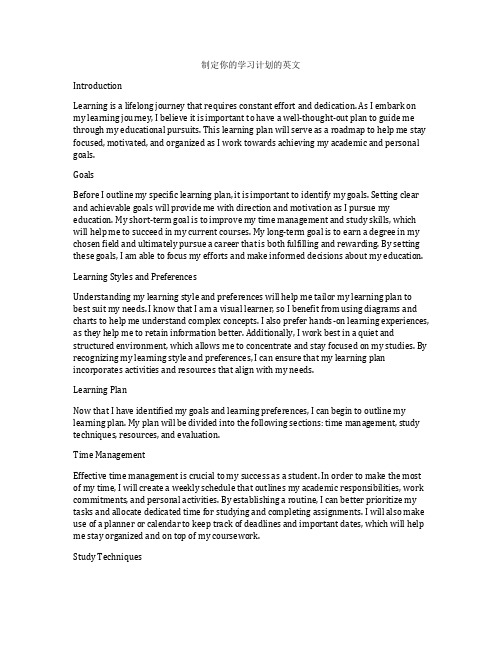
制定你的学习计划的英文IntroductionLearning is a lifelong journey that requires constant effort and dedication. As I embark on my learning journey, I believe it is important to have a well-thought-out plan to guide me through my educational pursuits. This learning plan will serve as a roadmap to help me stay focused, motivated, and organized as I work towards achieving my academic and personal goals.GoalsBefore I outline my specific learning plan, it is important to identify my goals. Setting clear and achievable goals will provide me with direction and motivation as I pursue my education. My short-term goal is to improve my time management and study skills, which will help me to succeed in my current courses. My long-term goal is to earn a degree in my chosen field and ultimately pursue a career that is both fulfilling and rewarding. By setting these goals, I am able to focus my efforts and make informed decisions about my education.Learning Styles and PreferencesUnderstanding my learning style and preferences will help me tailor my learning plan to best suit my needs. I know that I am a visual learner, so I benefit from using diagrams and charts to help me understand complex concepts. I also prefer hands-on learning experiences, as they help me to retain information better. Additionally, I work best in a quiet and structured environment, which allows me to concentrate and stay focused on my studies. By recognizing my learning style and preferences, I can ensure that my learning plan incorporates activities and resources that align with my needs.Learning PlanNow that I have identified my goals and learning preferences, I can begin to outline my learning plan. My plan will be divided into the following sections: time management, study techniques, resources, and evaluation.Time ManagementEffective time management is crucial to my success as a student. In order to make the most of my time, I will create a weekly schedule that outlines my academic responsibilities, work commitments, and personal activities. By establishing a routine, I can better prioritize my tasks and allocate dedicated time for studying and completing assignments. I will also make use of a planner or calendar to keep track of deadlines and important dates, which will help me stay organized and on top of my coursework.Study TechniquesDeveloping strong study techniques is essential for comprehending and retaining course material. I will incorporate a variety of study methods into my learning plan, including note-taking, active reading, and practice problems. For note-taking, I will use the Cornell method to help me summarize and organize key points from lectures and readings. Additionally, I will engage in active reading, which involves highlighting important information and asking questions to deepen my understanding of the text. Lastly, I will regularly practice problems and exercises to reinforce my knowledge and improve my problem-solving skills.ResourcesAccess to reliable resources is critical for enhancing my learning experience. I will utilize a variety of resources, including textbooks, online databases, academic journals, and educational websites. I will also make use of study groups, tutoring services, and academic support services offered by my college. By taking advantage of these resources, I can gain a deeper understanding of course material and seek assistance when needed. Additionally, I will explore extracurricular opportunities, such as workshops, seminars, and conferences, that are relevant to my field of study.EvaluationRegular self-assessment and feedback will be key components of my learning plan. I will evaluate my progress and performance using a variety of methods, such as quizzes, exams, assignments, and self-assessments. By regularly reviewing my work, I can identify areas for improvement and adjust my study habits accordingly. I will also seek feedback from professors, peers, and tutors, which will provide me with valuable insights and suggestions for growth.AdaptabilityLastly, I understand the importance of flexibility and adaptability in my learning plan. I will be open to making changes and adjustments as I progress through my education. If I encounter challenges or obstacles, I will be proactive in seeking solutions and seeking help when necessary. By remaining flexible, I can ensure that my learning plan remains effective and responsive to my evolving needs and circumstances.ConclusionIn conclusion, my learning plan is designed to provide me with a structured and comprehensive approach to my education. By setting clear goals, understanding my learning styles, and implementing effective strategies, I am confident that I will be able to succeed in my academic pursuits. I am committed to staying disciplined, motivated, and adaptable as I work towards achieving my goals. With this learning plan as my guide, I am ready to embrace the challenges and opportunities that lie ahead in my educational journey.。
描述类的英语作文
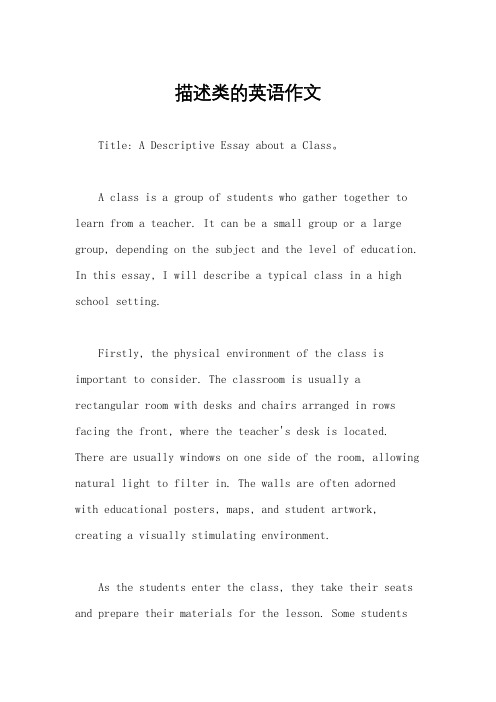
描述类的英语作文Title: A Descriptive Essay about a Class。
A class is a group of students who gather together to learn from a teacher. It can be a small group or a large group, depending on the subject and the level of education. In this essay, I will describe a typical class in a high school setting.Firstly, the physical environment of the class is important to consider. The classroom is usually a rectangular room with desks and chairs arranged in rows facing the front, where the teacher's desk is located. There are usually windows on one side of the room, allowing natural light to filter in. The walls are often adorned with educational posters, maps, and student artwork, creating a visually stimulating environment.As the students enter the class, they take their seats and prepare their materials for the lesson. Some studentsmay chat with their classmates, while others use this time to review their notes or complete any unfinished homework. The atmosphere in the class is usually a mix of excitement and anticipation, as the students are eager to learn and engage with the day's lesson.Once the class begins, the teacher takes the lead, standing at the front of the room and addressing the students. The teacher may use a whiteboard or a projector to display visual aids, such as slides or videos, to enhance the learning experience. The teacher's voice fills the room as they explain the day's topic, asking questions and encouraging student participation.The students listen attentively, taking notes and asking questions when they need clarification. Some students may raise their hands to answer questions or contribute to the discussion, while others may prefer to listen and absorb the information. The teacher uses a variety of teaching methods to cater to different learning styles, such as lectures, group discussions, and hands-on activities.In the middle of the class, there may be a short break, allowing the students to stretch their legs, use the restroom, or grab a quick snack. This break provides abrief respite from the intensity of the lesson and allows the students to recharge before diving back into the material.As the class comes to an end, the teacher summarizesthe key points of the lesson and assigns homework orprojects to reinforce the learning. The students gathertheir belongings and prepare to move on to their next class, chatting with their friends and exchanging ideas about the lesson.In conclusion, a class is a dynamic and interactive environment where students come together to learn and grow. The physical space, the teacher's guidance, and thestudents' engagement all contribute to the rich tapestry of a class. It is a place where knowledge is shared, ideas are explored, and friendships are formed, making it anessential part of the educational experience.。
认真听讲 怎么写英语作文
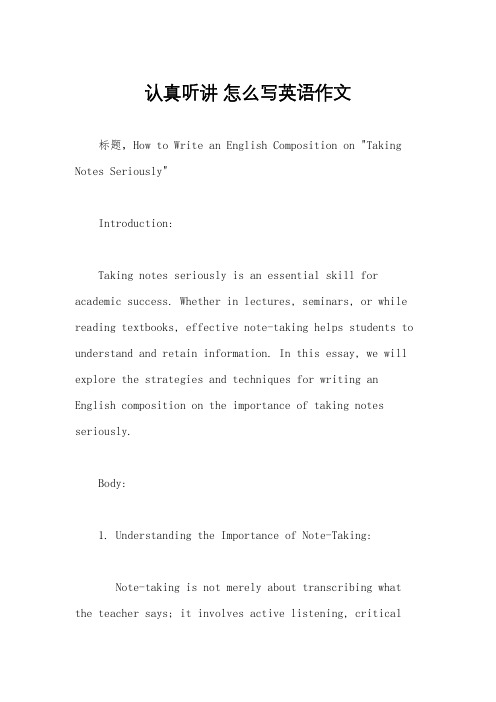
认真听讲怎么写英语作文标题,How to Write an English Composition on "Taking Notes Seriously"Introduction:Taking notes seriously is an essential skill for academic success. Whether in lectures, seminars, or while reading textbooks, effective note-taking helps students to understand and retain information. In this essay, we will explore the strategies and techniques for writing an English composition on the importance of taking notes seriously.Body:1. Understanding the Importance of Note-Taking:Note-taking is not merely about transcribing what the teacher says; it involves active listening, criticalthinking, and summarization. Effective notes serve as a reference for studying, help in comprehension, and aid in memory retention. Students who take notes seriously tend to perform better in exams and have a deeper understanding of the subject matter.2. Techniques for Effective Note-Taking:a. Active Listening: Engage with the material being presented actively. Listen for key points, examples, and explanations.b. Use of Abbreviations and Symbols: Develop a system of shorthand that allows for quick note-taking without sacrificing comprehension.c. Organization: Divide notes into sections, use headings, bullet points, or numbering to organize information logically.d. Review and Revision: Regularly review and revise notes to reinforce learning and fill in any gaps inunderstanding.3. Note-Taking Strategies for Different Situations:a. Lectures: Focus on capturing main ideas, key concepts, and supporting details. Pay attention to the structure of the lecture and any emphasis the speaker places on certain points.b. Seminars/Discussions: Note down different perspectives, arguments, and examples presented by participants. Capture any questions raised and their answers for further exploration.c. Textbook Reading: Highlight important passages, make marginal notes, and summarize each section in your own words. Create concept maps or diagrams to visualize complex information.4. Benefits of Taking Notes Seriously:a. Enhanced Understanding: Active note-takingpromotes deeper comprehension of the subject matter.b. Improved Retention: Writing down informationhelps commit it to memory.c. Effective Study Aid: Well-organized notes serveas a valuable resource for exam preparation and assignments.d. Critical Thinking Skills: Analyzing information and summarizing it in notes fosters critical thinking abilities.Conclusion:In conclusion, taking notes seriously is a fundamental skill that contributes to academic success. By employing effective techniques and strategies, students can maximize their learning potential and develop essential skills for lifelong learning. Remember, the art of note-taking is not just about capturing words on paper; it's about engagingwith the material, synthesizing information, and actively participating in the learning process. So, next time you'rein class or reading a textbook, grab your pen and paper, and take notes seriously!。
仓促的交作业英语
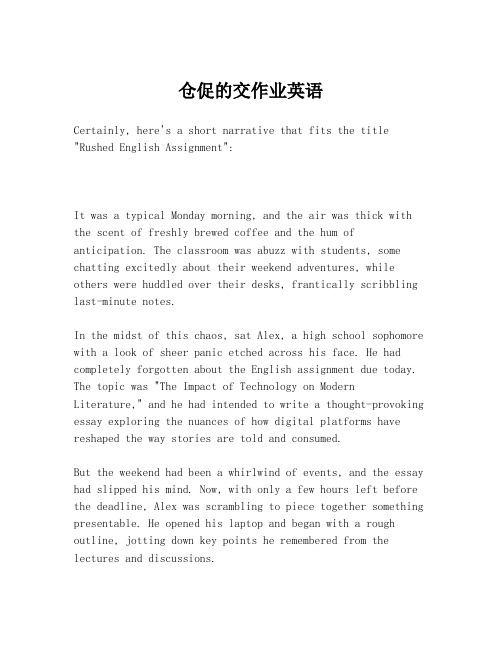
仓促的交作业英语Certainly, here's a short narrative that fits the title "Rushed English Assignment":It was a typical Monday morning, and the air was thick with the scent of freshly brewed coffee and the hum of anticipation. The classroom was abuzz with students, some chatting excitedly about their weekend adventures, while others were huddled over their desks, frantically scribbling last-minute notes.In the midst of this chaos, sat Alex, a high school sophomore with a look of sheer panic etched across his face. He had completely forgotten about the English assignment due today. The topic was "The Impact of Technology on Modern Literature," and he had intended to write a thought-provoking essay exploring the nuances of how digital platforms have reshaped the way stories are told and consumed.But the weekend had been a whirlwind of events, and the essay had slipped his mind. Now, with only a few hours left before the deadline, Alex was scrambling to piece together something presentable. He opened his laptop and began with a rough outline, jotting down key points he remembered from the lectures and discussions.As the clock ticked away, Alex's fingers danced across the keyboard, typing furiously. He delved into the effects of social media on storytelling, the rise of self-publishing,and the challenges authors face in an era dominated bydigital distractions. He cited examples of authors who have successfully adapted to the digital age, weaving their narratives into the fabric of social media platforms and interactive websites.With a sense of urgency, Alex also touched upon the potential loss of traditional storytelling methods and the importanceof preserving the essence of literature. He argued that while technology has opened up new avenues for creativity and accessibility, it is crucial to maintain a balance between innovation and the timeless art of storytelling.As the final minutes of the period approached, Alex proofread his essay, making quick corrections to grammar and syntax. He saved the document, attached it to an email, and hit sendjust as the bell rang, signaling the start of class.His heart pounded in his chest as he looked at the sent email, a mix of relief and anxiety swirling within him. He knew his essay was far from perfect, hastily written and lacking the depth he had initially envisioned. But in the face of a looming deadline, Alex had managed to produce a piece that, despite its rushed nature, still conveyed his understandingof the subject matter.As the English teacher began to take attendance, Alex satback in his chair, a lesson learned. He vowed to bettermanage his time and prioritize his assignments, ensuring that he would never again find himself in such a precarious situation. The experience, though stressful, had taught him the importance of planning and the consequences of procrastination.This narrative provides a snapshot of a student's experience with a rushed English assignment, highlighting the challenges and the lessons learned from such a situation.。
- 1、下载文档前请自行甄别文档内容的完整性,平台不提供额外的编辑、内容补充、找答案等附加服务。
- 2、"仅部分预览"的文档,不可在线预览部分如存在完整性等问题,可反馈申请退款(可完整预览的文档不适用该条件!)。
- 3、如文档侵犯您的权益,请联系客服反馈,我们会尽快为您处理(人工客服工作时间:9:00-18:30)。
Lecture One Manuscript Form✿4. Writing test forms & requirements in TEM-4Two sections of writing tested in TEM-4: Section A (Composition) (15 marks)& Section B (Note-writing) (10 marks)1)Section A: Composition (200 words in 35 minutes )Y ou’re required to write a composition of about 200 words on a certain topic implied in the given context. Generally speaking, marks will be awarded for content, organization, grammar, and appropriacy.Namely, writing a composition of about 200 words according to the given title/outline/instructions/figure statistics, etc., right grammar, accurate words, fluent expressions, relevant content, rigid organization, and proper style are required.The writing style may be argumentative, expositive, narrative, and descriptive. In most cases, the former two styles are tested in TEM-4, esp., argumentative. The topic of a composition tested in TEM-4 is usually about college students’life, study, and heated social problems, etc. which students are familiar with.(The Best Way to Stay Healthy 2002; To Save Money or Not 2006; My View on University Art Festival 2005)2)Section B: Note-writing (50-60 words in 10 minutes)(1)Note-writing is a type of informal letters, generally including Notices, Notes,Greetings, Letters, Invitations, Congratulations, Inquire s, etc.(2)Note-writing in TEM-4 includes Date, Addressing/Heading, Body, Closing, andSignature in terms of format.(3)ContentY ou’re required to write a note based on the given situations. Marks will be awarded for content, organization, grammar, and appropriacy. Here, grammar mistakes & spelling errors will result in a loss of many marks.(4)Y our note cannot have words more than 80 nor less than 40.1. General principles of writing the title1) Write the title in the middle of the first line of a page;2) Capitalize the key words in the title (including words following hyphens in compound words);3) Not capitalize articles (a, an, the), coordinating conjunctions (and, or, but, nor, for,), short prepositions(in, on, at, to, for..), nor the to in infinitives; but if one f them is at the beginning of a title, it should be capitalized;4)No period is used at the end of a title;(Use a question mark if the title is a direct question, but do not use one if it is anindirect question);5) Use quotation marks with quotes or titles of articles;6) Underline/ italicize names of books.❁Note: Y ou can capitalize each letter of the words in the title (full capitalization), or you can capitalize the initial letter of key words in the title.IV. CapitalizationCapitals are used mainly at three places:1.Capitalize the first words of a sentence;Not only a complete sentence, but a sentence fragment treated as a sentence in order to create a special effect in some novels/prose, should begin with a capital letter.For example: Money. Money. Money. It makes the world go round.2.Capitalize the title /a work of art;3.Capitalize proper nouns and their abbreviations;Proper nouns are the names of specific people, places, or things, names that set off the individual form the species. The following are all proper nouns:V. Word DivisionNever squeeze a word into the margin; you have to decide whether to divide the word or to write it on the next line. There are some principles of dividing words.The general principle of dividing a word according to its syllables.Some other principles:1.One-syllable words like thought, park cannot be divided;2.Do not write one letter of a word at the end or at the beginning of a line, even ifthat one letter makes up a syllable, such as a-wake, rain-y;3.Do not put a two-letter syllable at the beginning of a line, like hat-ed, cab-in;4.Avoid separating proper names of people or places, such as Chi-na, Pa-ris;5.Divide hyphenated words only at the hyphen: sister-in-law, second-handed,well-known;6.Do not divide words in a way that may mislead the reader: re-ally, pea=cock;7.Do not divide the last word on a page; you may write the whole word on the nextpage;8.Divide words with prefixes or suffixes between the prefix or suffix and the basepart of the word, such as develop-ment, un-like, careful-ness, ir-regular,9.Divide two-syllables words with double consonants between the two consonants:set-ting, quar-rel, bet-ter.VI. Punctuation1.The general uses of punctuations:1) Put one space after punctuation;2) Put no space before punctuation, but always put a space between words;Exceptions: a. put 2 spaces after colon (:) and between sentences,b. put no space after periods/stops (.) inside abbreviations,c. put no space before or after an apostrophe (——),d. put no space on the ―inside‖ of parentheses[ ( ) ].3) Put end-of –sentence punctuation inside quotation marks (―‖);E.g.: ---―Did you go the zoo yesterday?‖ she asked her son.---―Y es, I did,‖ he said.―I had a good time there.‖4) Put commas (,) and other punctuation outside of parentheses;5) Put a comma & a space before and, but, or, nor when they join 2 dependentclauses within a sentence;6) If you use an adj.-plus-noun/adv.-adj./… phrase to modify another noon, this kindof phrase should be joined with hyphen (-), (e.g.: two-part solution; ) 7) Names of newspapers, books, movies, ships, magazines, journals, and poems areusually italicized or underlined;8) Ellipsis(…) is used to show that something has been omitted (three dots only);9) The semicolon (;) is not used widely in English and probably should be avoidedby non-native speakers/writers’✿2. Quotation marks & the quoted speech1)Double quotation marks are used to enclose direct quotations either indialogue or from a book; single quotation marks are used to enclose aquotation within a quotation.(1)Chomsky suggested that,―L anguage is a system that can be described in analgebraic notation.‖(2)Clinton said,―H ow do you like my budget?‖2)W hen other marks of punctuation are used with quoted words, phrases, orsentences, American practices are as follows:The period (.) & the comma (,) are placed within the quotation marks,A.如果一句话的成分被说话动词隔开(包括主、谓语/主、从句/呼语与句子等的隔开),中间都用“,”,只需大写被引用句中的第一个单词的首字母(特殊的专有名词除外)。
